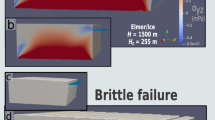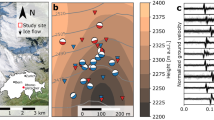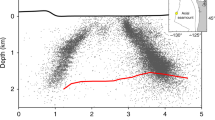Abstract
OBSERVATIONS of Antarctic super tabular icebergs1–5, which can exceed 100 km on a side, have shown that their origin can frequently be traced to previously existing super ice tongues, which are a class of massive seawards-extending ice shelves. Furthermore, a history of cyclic growth and calving can often be inferred2–4 or demonstrated6,7. Because the calvings do not generally occur along a line coincident with the grounding line, where, under normal tidal flexure the stresses are greatest8,9, and because multiple fracturing is observed1,2 we have sought a nontidal theory for ice-tongue fracture9. A mechanism for generating significant bending stresses at locations along an ice tongue far from the grounding zone is by vibration of the glacier in a mode higher than the fundamental10. In this report, we outline an approximate analysis of the modes of free vibration of a buoyant, elastic, tapering ice tongue floating in shallow water of variable depth.
This is a preview of subscription content, access via your institution
Access options
Subscribe to this journal
Receive 51 print issues and online access
$199.00 per year
only $3.90 per issue
Buy this article
- Purchase on Springer Link
- Instant access to full article PDF
Prices may be subject to local taxes which are calculated during checkout
Similar content being viewed by others
References
Law, P. G. Polar Rec. 13, 439 (1967).
Shamont'yev, V. A. Soviet Ant. exp. Inform. Bull. 7, 575 (1970).
Savatyugin, L. M. Soviet Ant. exp. Inform. Bull. 8, 28 (1970).
Tret'yakov, N. F. & Mikheyev, O. F. Soviet Ant. exp. Inform. Bull. 8, 30 (1970).
Swithinbank, C., McClain, P. & Little, P. Polar Rec. 18, 495 (1977).
Budd, W. F. J. Glaciol. 6, 335 (1966).
Holdsworth, G. J. Glaciol. 13, 27 (1974).
Holdsworth, G. Ann. Geophys. 33, 27 (1977).
Hughes, T. J. ISCAP Bull. No. 4 (1975).
Reeh, N. Bygningsstatiske Meddelelser. 41, 167 (1970).
Weinman, J. A. J. Glaciol. 3, 187 (1958).
Robinson, E. S., Williams, R. T., Neuberg, H. A. C., Rohrer, C. S. & Ayers, R. L., Ann. Geophys. 33, 147 (1977).
Weertman, J. J. Glaciol. 3, 38 (1957).
Thomas, R. H. Br. Antarctic Survey Sci. Rep., No. 70 (1973).
Tabata, T. Physics of Snow and Ice: Proceedings. Hokkaida Univ. 1, 481 (1967).
Shetty, D. K., Mura, T. & Meshii, M. Mater. Sci. Engng 20, 261 (1975).
Timoshenko, S. & Woinowsky-Kreiger, S. Theory of Plates and Shells (McGraw-Hill, New York, 1975).
Clough, J. W. Antarctic J.U.S. July/August, 159 (1974).
Author information
Authors and Affiliations
Rights and permissions
About this article
Cite this article
HOLDSWORTH, G., GLYNN, J. Iceberg calving from floating glaciers by a vibrating mechanism. Nature 274, 464–466 (1978). https://doi.org/10.1038/274464a0
Received:
Accepted:
Issue Date:
DOI: https://doi.org/10.1038/274464a0
This article is cited by
Comments
By submitting a comment you agree to abide by our Terms and Community Guidelines. If you find something abusive or that does not comply with our terms or guidelines please flag it as inappropriate.



